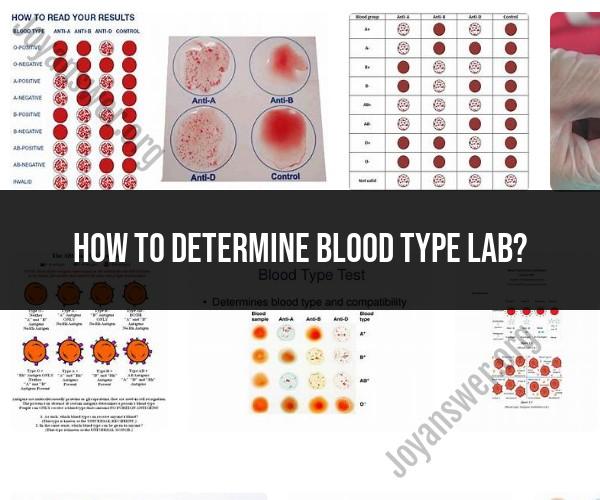How to determine blood type lab?
Blood Typing: An Overview
Blood typing is a crucial medical procedure that determines an individual's blood group based on specific antigens present on the surface of red blood cells. Knowing your blood type is essential for medical purposes, such as blood transfusions and organ transplants. Here's an overview of the procedures and tests used to determine blood type in a lab setting:
1. Blood Sample Collection
The first step in blood typing involves collecting a blood sample from the patient. This is typically done by a trained phlebotomist or a healthcare professional. A small amount of blood is drawn from a vein in the arm using a sterile needle and stored in a test tube.
2. Centrifugation
Once the blood sample is collected, it is placed in a centrifuge machine. Centrifugation separates the blood into its components: red blood cells, white blood cells, and plasma. This separation is crucial for subsequent testing.
3. Mixing with Antisera
To determine blood type, the separated red blood cells are mixed with specific antisera containing antibodies that react with the antigens on the red blood cell surfaces. There are two main systems for blood typing: the ABO system and the Rh system.
4. ABO Blood Typing
In the ABO system, the blood is tested for the presence or absence of antigens known as A and B antigens. The reaction with specific antisera determines whether the blood type is A, B, AB, or O. For example, if blood reacts with anti-A antibodies but not with anti-B antibodies, the blood type is A.
5. Rh Blood Typing
In the Rh system, the blood is tested for the presence or absence of the Rh antigen (also known as the Rh factor or D antigen). If the blood contains the Rh antigen, it is Rh-positive (+); if not, it is Rh-negative (-).
6. Cross-Matching
For blood transfusions, cross-matching is performed to ensure compatibility between the donor's blood and the recipient's blood. This is a critical step to prevent adverse reactions during transfusion.
7. Result Interpretation
After testing, the lab technician or healthcare professional interprets the results based on the reactions observed. The combination of ABO and Rh results determines the individual's complete blood type, such as A+, B-, AB+, O-, etc.
Conclusion
Determining blood type in a lab setting involves a series of precise procedures and tests to ensure accurate results. Blood typing is essential for medical care, particularly in emergency situations and blood transfusions, where compatibility is crucial for patient safety.
A Step-by-Step Guide to Determining Blood Type in a Laboratory
To determine blood type in a laboratory, the following steps are typically followed:
- Collect a blood sample. This can be done by pricking the patient's finger with a lancet or by drawing blood from a vein.
- Label the blood sample with the patient's name and date of birth.
- Centrifuge the blood sample to separate the red blood cells from the plasma.
- Add a drop of anti-A serum to one test tube and a drop of anti-B serum to another test tube.
- Add a drop of the patient's red blood cells to each test tube.
- Mix the blood cells and antisera.
- Wait for a few minutes for agglutination (clumping) to occur.
If the red blood cells agglutinate in the anti-A serum tube, the patient has type A blood. If the red blood cells agglutinate in the anti-B serum tube, the patient has type B blood. If the red blood cells agglutinate in both test tubes, the patient has type AB blood. If the red blood cells do not agglutinate in either test tube, the patient has type O blood.
Blood Typing: Laboratory Procedures and Protocols
There are a number of different blood typing procedures and protocols that can be used. Some of the most common methods include:
- Slide agglutination test: This is the simplest and most common blood typing method. It involves mixing a drop of the patient's red blood cells with a drop of anti-A and anti-B serum on a microscope slide. The slide is then examined for agglutination (clumping) of the red blood cells.
- Tube agglutination test: This method is similar to the slide agglutination test, but it is performed in test tubes instead of on a microscope slide.
- Microplate agglutination test: This method uses a microplate to test for agglutination of the patient's red blood cells with anti-A, anti-B, and anti-Rh serum.
- Gel card test: This method uses a gel card to test for agglutination of the patient's red blood cells with anti-A, anti-B, and anti-Rh serum.
The specific blood typing procedure or protocol that is used will depend on the laboratory's preferences and resources.
Understanding Your Blood Type: Lab Tests and Results
Your blood type is determined by the presence or absence of certain antigens on your red blood cells. Antigens are proteins that can trigger an immune response.
The four main blood types are A, B, AB, and O. People with type A blood have A antigens on their red blood cells. People with type B blood have B antigens on their red blood cells. People with type AB blood have both A and B antigens on their red blood cells. People with type O blood do not have A or B antigens on their red blood cells.
In addition to the ABO blood system, there is another blood group system called the Rh system. The Rh system is based on the presence or absence of the Rh antigen on red blood cells. People who have the Rh antigen on their red blood cells are Rh positive. People who do not have the Rh antigen on their red blood cells are Rh negative.
Your blood type is important to know for a number of reasons. For example, if you need a blood transfusion, you must receive blood from someone with a compatible blood type. Additionally, if you are pregnant, your blood type is important to know because it can affect your baby's blood type.
If you have any questions about your blood type, be sure to talk to your doctor. They can help you to understand what your blood type means and how it can affect your health.












